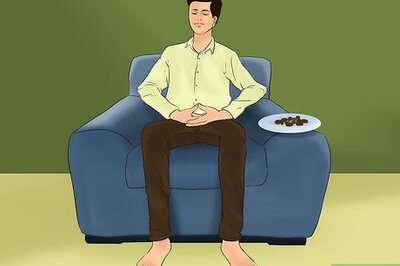
views
The CFOP Speedsolving Method
Inspection During a speedsolving competition, you have 15 seconds to inspect the scrambled cube before you start solving. CFOP solvers often use this time to work out how to make the white cross, which will be the first stage of the solving method. Huynh notes that the top five-second solvers now "basically know 70% about the whole solution with just inspecting [the cube] in 15 seconds," so this is a very important part of the solving process. When you're solving at home, you can take as much time as you want to inspect the cube and visualize your moves. If you're aiming to compete, though, you'll eventually want to start limiting yourself to a maximum of 15 seconds.
Cross For the first stage of the CFOP method, the goal is to create a white cross on the bottom face of the cube. While you can use algorithms at this stage, there are really too many to list. Most solvers complete this stage with pattern recognition and intuition. While it does make more sense to solve the cross on the top face and then just flip the cube over, practice doing it on the bottom if you want to eventually reach solve times under 20 seconds.
First two layers (F2L) When you first started solving, you were likely solving layer by layer. Huynh explains that F2L is "significantly quicker because you're doing two layers at once, but it's much trickier as well because in the beginner's method, you're just focusing on the corners, but in the F2L, you're doing corners and edges at the same time. So you're paying attention to different pieces." While there are some algorithms you can learn that will help you solve this stage more efficiently, most players find it easiest to solve by intuition when they're first starting out. With practice, you'll start to recognize patterns and learn the turns you need to make to get the first two layers lined up.
Orient last layer (OLL) In this stage, solve the top layer of the cube so that it's all yellow. At this point, you don't have to worry about whether all the side colors match—you'll fix that in the last step. It's usually best to start with the two-look OLL method, which requires learning fewer algorithms (even though it takes a little longer). According to Huynh, "two-look OLL is a method you learn pretty much after beginners if you want to improve."
Permute last layer (PLL) Start by rotating the top layer so that you've aligned as many pieces as possible. With practice, pattern recognition will make this much easier. Then, use one of the 21 PLL algorithms to complete your solve. As a beginner to the method, two-look PLL allows you to complete this stage without memorizing as many algorithms, although it does tend to require a few extra moves.
Skipping steps With more practice as you get more advanced, you might find that you can complete one stage in such a way that the next stage is already completed. This can potentially save you a lot of moves and drastically cut your time—but it's not something that's likely to happen very often. The more you practice, the more adept you'll get at recognizing patterns and understanding how those patterns potentially affect the solving so that you can choose a different method of solving that could shave off some moves.
Is CFOP the fastest speedsolving method?
CFOP is widely considered the fastest speedsolving method. It's definitely the most popular, with all of the world champions using some variation of it. The primary benefit of the CFOP method is that it relies a lot on memorization of algorithms and muscle memory, meaning that you can just practice and practice to become better. As you get used to pattern spotting, you'll be able to see not only the patterns on the cube but the patterns that will be created if you make specific moves. This allows you to think ahead and potentially skip steps. Thanks to muscle memory, you don't even have to think about the algorithms you've memorized after you've practiced them enough. Your brain will recognize a pattern and your fingers will know what to do in response to that pattern without you even actively thinking about it. Most beginner's methods use some parts of the CFOP method, which also makes it the easiest method to pick up first if you want to learn some more advanced solving methods.
Beginner Algorithms
Memorize the Singmaster algorithm notation. Singmaster move notation is the most commonly used way to write the algorithms you'll need to solve a Rubik's cube puzzle using the CFOP method. The basic moves are notated using the first letter: Up, Down, Right, Left, Front, Back. These orientations are based on how you're looking at the cube, so the "up" side is the side on the top as you're looking at it. A single letter means that you turn that side clockwise, as if you were facing it. If there's an apostrophe after the letter (called a "prime" in Singmaster notation), turn that face counter-clockwise instead. If there's a 2 after the letter, it means to turn that side twice. Wide moves turn 2 layers at once and are denoted by lower-case letters, rather than upper-case letters. Cube rotations are denoted with x, y, and z. For x, you rotate the cube right, up for y, and front for z. Slice moves turn the middle layer and are denoted with M, E, and S. For M, turn to the left. For E, turn down. When you see an S, turn the layer to the front.
Use the two-look OLL method to simplify OLL algorithms. When you're just starting out, it's going to be tough to memorize an algorithm. After you've memorized your first one and practiced with it, though, it'll become second nature. As you go, muscle memory means each new algorithm will take progressively less time for you to pick up. But as a beginner, the two-look OLL method allows you to practice the CFOP method while only learning 9 algorithms: Dot shape (edges): F R U R' U' F' f R U R' U' f' I-shape (edges): F R U R' U' F' L-shape (edges):' f R U R' U' f' Antisune (corners): R U2 R' U' R U' R' H (corners): R U R' U R U' R' U R U2 R' L (corners): F R' F' r U R U' r' Pi (corners): R U2 R2 U' R2 U' R2 U2 R Sune (corners): R U R' U R U2 R' T (corners): r U R' U' r' F R F' U (corners): R2 D R' U2 R D' R' U2 R'
Permute the last layer by solving the corners, then the edges. This is called "two-look PLL" and only requires you to learn 6 algorithms, which is a lot easier than learning the 21 total PLL algorithms. It does require you to break the PLL process down into two separate stages and solve the corners first, then solve the edges. Use the following algorithms: Diagonal (corners): F R U' R' U' R U R' F' R U R' U' R' F R F' Headlights (corners): R U R' U' R' F R2 U' R' U' R U R' F' PLL (H) (edges): M2 U M2 U2 M2 U M2 PLL (Ua) (edges): R U' R U R U R U' R' U' R2 PLL (Ub) (edges): R2 U R U R' U' R' U' R' U R' PLL (Z) (edges): M' U M2 U M2 U M' U2 M2
Advanced Algorithms
Complete the OLL stage in a single step. Once you've got the two-look OLL stage down, you might decide that you're ready to take your skills up a notch and go to the straight OLL, the kind all the pros use. This stage has a whopping 57 algorithms to memorize, but once you do, you'll be able to save every permutation of the top layer using a single sequence of moves. Essentially, these 57 algorithms give you the code to solve the Rubik's Cube puzzle from this stage of the process. Like the beginner algorithms you learned, all of these algorithms can be drilled until it becomes like second nature for your fingers to move in response to the pattern you see.
Pick up the rest of the PLL algorithms. There are 21 total algorithms for the PLL stage if you're not doing it in two looks. The great thing is that you've already learned 6 of these for the two-look PLL, so now you only have 15 left to master. Drill the algorithms in small groups to learn them for quicker mastery. For example, you might learn 5 algorithms and drill them for a week, then learn the next 5 and alternate drilling them and drilling the new ones.
Look for patterns that predict future patterns. After you've practiced for a while, you'll start to see patterns that you recognize. Some of these patterns will enable you to unlock other patterns with just a few turns. These are effectively shortcuts that you'll find along the way. While CFOP is a less intuitive method than some others, incorporating pattern recognition can help you complete the stages of the method even faster.
Improving Your Speedsolving Time
Keep your cube well-lubricated. A well-lubricated cube just moves smoother and faster than one that's not. Once you're confident in your movements, you'll find that you can turn a well-lubricated cube much more quickly and with a lot less effort. A well-lubricated cube also decreases the resistance, which can lower your risk of hand and wrist repetitive-use injuries. You reduce the risk that the cube will lock up as well, which could totally ruin your time. Silicone grease and silicone sprays tend to work a bit better for lubricant than WD-40, which can make the cube (and your fingers) a bit sticky.
Practice strong finger placement. The more types of moves you can make without moving your fingers, the faster you'll be able to make those moves. Choose the finger positions that give you the most mobility and allow you to manipulate the cube in as many ways as possible without changing those finger positions. This is also part of building muscle memory because your fingers will automatically know exactly where to move and what to do when they are oriented in the same position on the cube every time you pick it up. During competition, use a couple of seconds of your inspection time to make sure that your fingers are in a good position and you're holding the cube in the way that's most comfortable for you.
Visualize the moves as you look at the scrambled cube. As you recognize patterns, apply the algorithm mentally by visualizing your fingers making the required moves or just the cube moving in the way that you want. Practice running through the whole algorithm mentally before you set your fingers to it. Doing this will make your movements more automatic. The aim of this exercise is to decrease the delays between moves so that your fingers seem to be moving synchronously in many different directions at once. Because your fingers already know what to do next, they'll anticipate that action, which also helps you get faster.
Keep your hands in a neutral position and hold the cube stable. Hold the cube steady in one place rather than moving it around. As you make moves, focus on moving only your fingers and keeping your palms steady at all times. Steady palms will keep the cube stable and make it less likely to slip. There are some moves that you can't complete without moving your hand. But when you make those moves, you can still keep your hands as still as possible. Think in terms of making a subtle tip of your hand rather than an exaggerated movement that will take more time to complete.
Move with delicate precision rather than brute force. If you started out playing with a cheaply made cube, you might be used to handling it with more force than might be strictly necessary—especially if you start practicing with a competition-grade cube. Using less force also conserves energy, which means that your fingers will be able to move a little faster. When you focus on accuracy and making precise movements, you might also find that you can pull off little finger tricks that you learn with more consistency. On the other hand, turning aggressively can actually cause your cube to lock up—and that certainly won't do anything to improve your time.
Drill algorithms regularly. Huynh recommends that you "just sit and drill your algorithms, make sure your finger tricks are good and make sure you master them." Top solvers may know up to 3,000 algorithms, which obviously you can't sit and drill all at once. When you get to the point where you know quite a few, Huynh advises that "spaced repetition is a good tool to use if you're learning a lot of algorithms or just in general." The more often you drill algorithms, the more natural and automatic the finger movements will become. It'll also take less time for you to think about the algorithm before you execute it.
Experiment with different algorithms and finger tricks. Once you've memorized the algorithms, you can start playing around and figure out which ones work best for you, given all the different variables including hand and finger size and dexterity. Pinpoint the algorithms that are most comfortable for you, then work on pattern spotting to identify situations when you can use that algorithm—or make a few minor adjustments that will set you up for that algorithm. Huynh emphasizes that getting faster is really about "improving your skills little by little and not worrying about who has what time." He encourages beginners to "think about it in the long run because when you learn a new method, you're going to be slower than you were."




















Comments
0 comment